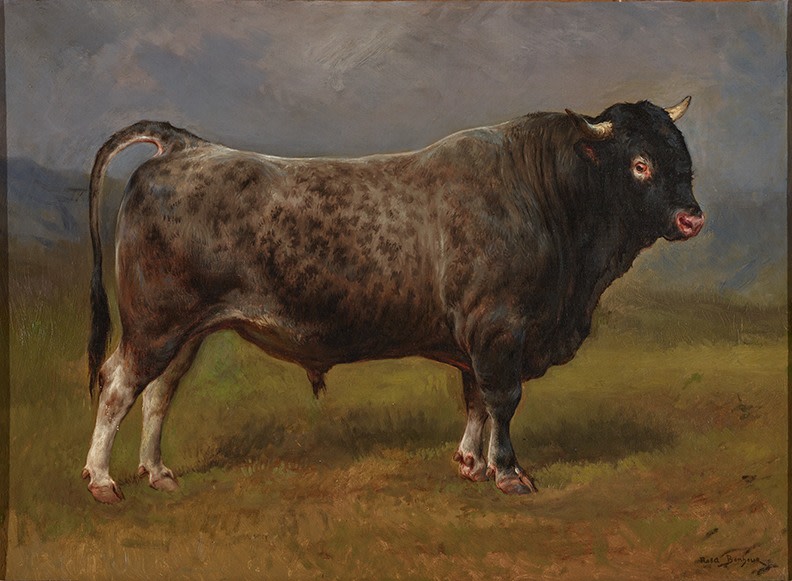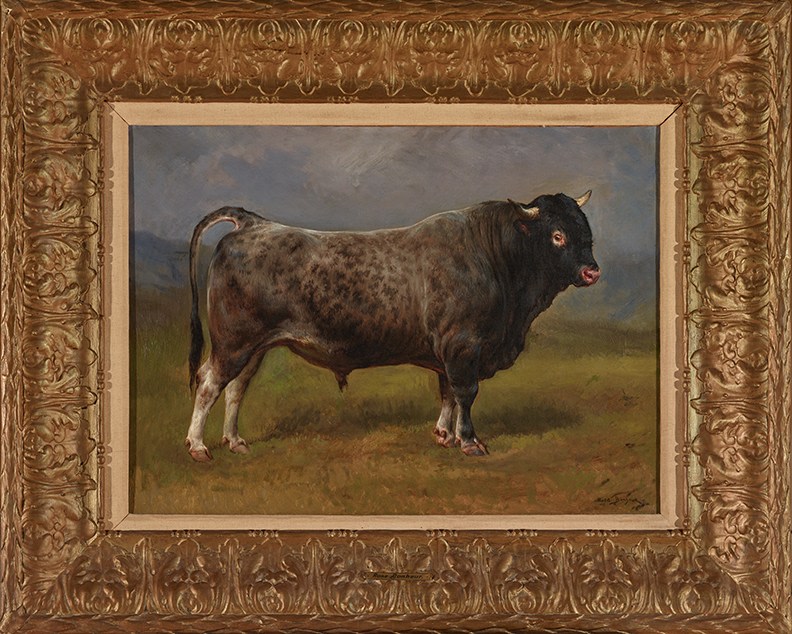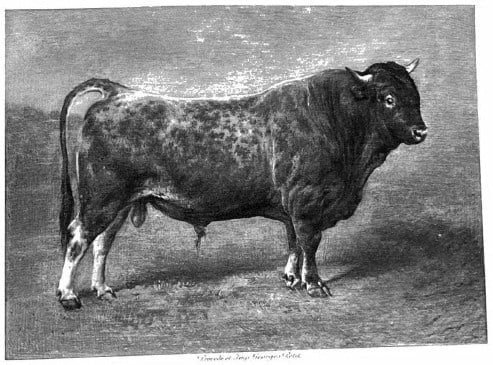"As for males, I like only the bulls I paint." - Rosa Bonheur
A sympathetic approach permeates this 'portrait', as indeed it is a portrait. There is no fierce quality to him; he is presented as a lonely soul, resting before the storm.
Provenance
Artist (and sold, Galerie Georges Petit, Paris, 30 May-2 June 1900, lot 202, as Le Taureau gris)Sale: Ivey-Selkirk, St. Louis, 10 June 2012, lot 503, as Portrait of a Bull Standing in a Field.
Acquired at the above sale by the present owner
Literature
"Les grandes ventes", Bulletin de la Société française des amis des arts, Paris, 25 May 1900, p. 31.
"Mouvement des arts," La Chronique des arts et de la curiosité, Paris, no. 26, 28 July 1900, p. 242.
(probably) A. Klumpke, Rosa Bonheur, sa vie, son œuvre, Paris, 1908, p. 427, as Taureau dans la prairie.
Catalogue note
'En matière de mâles je n’aime que les taureaux que je peins' ('As for males, I like only the bulls I paint') - Rosa Bonheur. The witticism is surprising; while Bonheur painted many oxen, there are relatively few representations of bulls- castrated oxen- in her corpus. The present painting was sold after Bonheur’s death at the Atelier sale of more than 2,000 works organized by the Galerie Georges Petit. Lot 202 brought 2,400 francs, a relatively meager result for its size and for a Bonheur generally. Authorized by Anna Klumpke as a conciliating gesture to appease Bonheur’s family who was suing her for inheritance, the flood of pictures onto the market triggered a crash of Rosa's prices. Le taureau gris probably corresponds to the Taureau dans la prairie dated by Klumpke to 1886 in the small catalogue of essential works included at the end of her monograph dedicated to her companion (A. Klumpke, Rosa Bonheur, sa vie, son oeuvre, p.427). Though not illustrated in her volume, the date, 1886, matches Bonheur's style around that period. The looseness of the brushwork, the total absence of impasto, which gives to this large canvas an almost watery effect kin to watercolor, are sometimes encountered in other of her paintings datable to 1885-1886. The bull represented here- reddish eye and nostril, majestic in appearance with his tail raised above the rest of the body - is a specimen of the Bazadaise breed also known as gris de Bazas from the town of the Gironde to which the breed owes its name. The Bazadaise cattle are massive animals - uncastrated males easily reach 2,200 pounds. In the nineteenth century, they were used as draft animals, which accounts for the short legs and powerful groins, whereas today their legs are slightly longer because modern farmers raise them exclusively for meat.
In a stormy landscape, against a dark sky and bluish mountains rendered in broad, almost splashing, brushwork, the bull dominates the scene. Even its shadow enlivens the tender green of the field. His dappled coat, in which touches of brown and dark gray cover the white of the underpainting, contrasts with the deeper gray of his head, neck and frontal body, all masterfully painted. A sympathetic approach permeates this 'portrait', as indeed it is a portrait. There is no fierce quality to him; he is presented as a lonely soul, resting before the storm. To express her perception of this creature, she has used a somewhat speedy, freer, approach to the brushwork, which she was experimenting with then: it results in more directness and contributes to express a mood. The painting is one of the most moving representations of an animal - an innocent victim of man’s exploitation- which she has produced. We are grateful to Dr. Annie-Paule Quinsac for confirming the authenticity of this painting and for her contribution of the above note and expertise.
We would also like to note that our painting would appear to represent an ox, altered by castration. Interestingly, in an earlier photograph illustrated in the catalogue for the Rosa Bonheur studio sale in 1900, the anatomy of the bull was different - the beast is shown intact (see fig, 1). We believe the alteration was to the image and not the animal. Such types of changes (usually requested by a subsequent owner) were not infrequent, and one may make a comparison with paintings of naked putti, whose bodies sometimes ended up swathed in drapery.






